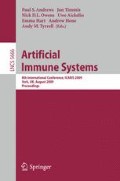Abstract
This paper presents an unsupervised structure damage classification algorithm based on the data clustering technique and the artificial immune pattern recognition. The presented method uses time series measurement of a structure’s dynamic response to extract damage-sensitive features for the structure damage classification. The Data Clustering (DC) technique is employed to cluster training data to a specified number of clusters and generate the initial memory cell set. The Artificial Immune Pattern Recognition (AIPR) algorithms are integrated with the data clustering algorithms to provide a mechanism for the evolution of memory cells. The combined DC-AIPR method has been tested using a benchmark structure. The test results show the feasibility of using the DC-AIPR method for the unsupervised structure damage classification.
Access this chapter
Tax calculation will be finalised at checkout
Purchases are for personal use only
Preview
Unable to display preview. Download preview PDF.
References
Kolakowski, P.: Structural Health Monitoring - a Review with the Emphasis on Low-Frequency Methods. IPPT Engineering Transactions 55, 239–275 (2007)
Sazonov, E., Janoyan, K., Jha, R.: Wireless intelligent sensor network for autonomous structural health monitoring. Proc. SPIE - Int. Soc. Opt. Eng. 5384, 305–314 (2004)
De Castro, L.N.: Fundamentals of Natural Computing: Basic Concepts, Algorithms, and Applications. Chapman & Hall/CRC, Boca Raton (2006)
Hart, E., Timmis, J.: Application areas of AIS: the past, the present and the future. Applied Soft Computing Journal, 191–201 (2008)
Dasgupta, D.: Advances in artificial immune systems. IEEE Computational Intelligence Magazine 1, 40–49 (2006)
Freitas, A.A., Timmis, J.: Revisiting the foundations of artificial immune systems for data mining. IEEE Transactions on Evolutionary Computation 11, 521–540 (2007)
Watkins, A., Timmis, J., Boggess, L.: Artificial immune recognition system (AIRS): an immune-inspired supervised learning algorithm. Genetic Programming and Evolvable Machines|Genetic Programming and Evolvable Machines 5, 291–317 (2004)
Zhong, Y.F., Zhang, L.P., Gong, J.Y., Li, P.X.: A supervised artificial immune classifier for remote-sensing imagery. IEEE Transactions on Geoscience and Remote Sensing 45, 3957–3966 (2007)
Dasgupta, D., KrishnaKumar, K., Wong, D., Berry, M.: Negative selection algorithm for aircraft fault detection. In: Nicosia, G., Cutello, V., Bentley, P.J., Timmis, J. (eds.) ICARIS 2004. LNCS, vol. 3239, pp. 1–13. Springer, Heidelberg (2004)
Taylor, D.W., Corne, D.W.: An Investigation of the Negative Selection Algorithm for Fault Detection in Refrigeration Systems. In: Timmis, J., Bentley, P.J., Hart, E. (eds.) ICARIS 2003. LNCS, vol. 2787, pp. 34–45. Springer, Heidelberg (2003)
Cesana, E., Beltrami, S., Laface, A.E., Urthaler, A., Folci, A., Clivio, A.: Current paradigms in immunology. In: Apolloni, B., Marinaro, M., Nicosia, G., Tagliaferri, R. (eds.) WIRN 2005 and NAIS 2005. LNCS, vol. 3931, pp. 244–260. Springer, Heidelberg (2006)
Negoita, M.: Artificial immune systems - an emergent technology for autonomous intelligent systems and data mining. In: Gorodetsky, V., Liu, J., Skormin, V.A. (eds.) AIS-ADM 2005. LNCS (LNAI), vol. 3505, pp. 19–36. Springer, Heidelberg (2005)
Structural Health Monitoring Benchmark Problem, http://mase.wustl.edu/wusceel/asce.sshm/benchmarks.htm
Theodoridis, S., Koutroumbas, K.: Pattern Recognition. Academic Press, London (2008)
Pearson, K.: On Lines and Planes of Closest Fit to Systems of Points in Space. Philosophical Magazine 2, 559–572 (1901)
Sammon, J.W.: A nonlinear mapping for data structure analysis. IEEE Trans. on Computers 18, 401–409 (1969)
Chen, B., Zang, C.: Artificial immune pattern recognition for damage detection in structural health monitoring sensor networks. In: Proc. of SPIE: Smart Sensor Phenomena, Technology, Networks, and Systems, San Diego, California (2009)
De Castro, L.N., Von Zuben, F.J.: Learning and optimization using the clonal selection principle. IEEE Transactions on Evolutionary Computation 6, 239–251 (2002)
Author information
Authors and Affiliations
Editor information
Editors and Affiliations
Rights and permissions
Copyright information
© 2009 Springer-Verlag Berlin Heidelberg
About this paper
Cite this paper
Chen, B., Zang, C. (2009). Unsupervised Structure Damage Classification Based on the Data Clustering and Artificial Immune Pattern Recognition. In: Andrews, P.S., et al. Artificial Immune Systems. ICARIS 2009. Lecture Notes in Computer Science, vol 5666. Springer, Berlin, Heidelberg. https://doi.org/10.1007/978-3-642-03246-2_21
Download citation
DOI: https://doi.org/10.1007/978-3-642-03246-2_21
Publisher Name: Springer, Berlin, Heidelberg
Print ISBN: 978-3-642-03245-5
Online ISBN: 978-3-642-03246-2
eBook Packages: Computer ScienceComputer Science (R0)

